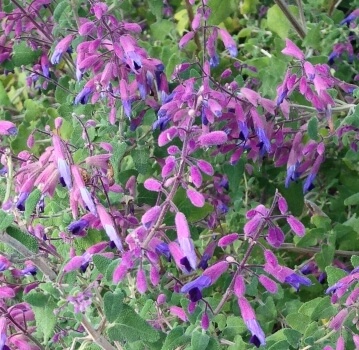While many of us jump to the edible sage, Salvia officinalis, when we think of salvias, it is one of the most diverse and heavenly-scented plants in the gardening world.
From the stunningly playful Salvia ‘Hot Lips’, to the neon blue of Salvia ‘Blue Butterflies’, the extension of this genus, and the dozens of cultivars in each of the species groups makes it one of the most important plants for any gardener to get to know.
To learn more and understand these gorgeous mediterranean plants in detail, as well as how to grow them, read through our guide to growing sage (Salvia officinalis), which provides hints and tips that are relevant to every form of salvia imaginable.
More...
Family: | Lamiaceae |
|---|---|
Genus: | Salvia |
Species: | Roughly 1000 recognised species |
Common Names: | Salvia, Sage |
Location: | Outdoor |
Type: | Shrubs and herbaceous perennials (some annuals) |
Growth: | Varied from 20cm x 20cm to 1m x 2m (H x W) |
Sun requirements: | Full sun |
Foliage Colour: | Green, Black, Silver, Yellow |
Flower Colour: | Purple, Pink, Blue, Red, White |
Flowering: | Summer to autumn |
Fruit: | None |
Maintenance level: | Low |
Poisonous for pets: | Non-toxic to cats and dogs |
What are Salvias?

Salvias are one of the largest genera of plants in the world, and the most widespread genus in the mint family, Lamiaceae. While they are mostly perennial plants, some species are actually annual, and while they require the same growing conditions as their perennial cousins, they will grow and flower from seed in a single year before dying back and not returning.
These salvias are noted below as annuals and should be resown each year. What they add in maintenance they make up for in beauty though, so for more vivid colour and fresher foliage, it's worth considering them as a friend, not a challenge.
The Best Salvias to Grow in Australia
There are far too many different types of sage plants to list in a single article, with over 1000 species, and dozens of cultivars within each species group. However, I’m a fan of salvias and didn’t want to let that stop me, so below is a comprehensive guide to my forty favourite Salvias that you can grow successfully here in Australia which, in the majority, are rated on their leaf fragrance above all else.
1. Common sage (Salvia officinalis)
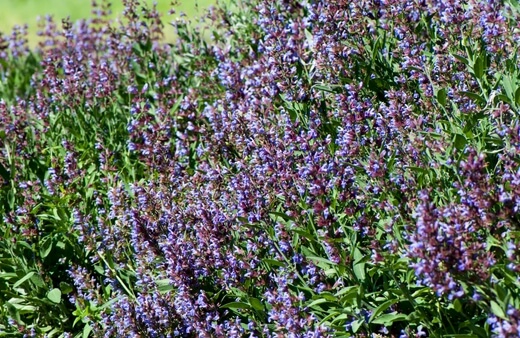
Sage, or Salvia officinalis, is the most commonly grown salvia in the world. It is largely grown as a food crop, but flowers with gorgeous blue flowers year after year, and will over winter well in beds and borders provided the soil doesn’t become waterlogged.
- Height & Spread: 1mx1m
- Edible: Yes
- Annual or Perennial: Perennial
Here is comprehensive guide to growing Salvia officinalis in Australia.
2. Rosemary (Salvia rosmarinus)
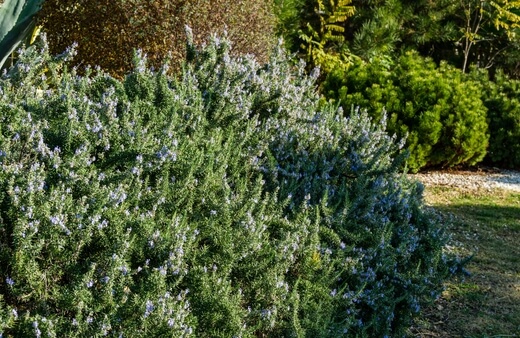
Rosemary is a Salvia, but with distinctly different features. Its narrow leaves have a richer flavour that works well with almost any savoury dish, and its woody stems are incredibly easy to care for in any sunny spot on well-drained soil.
In summer, you can expect a flush of delicate purple flowers that bees and pollinators adore.
- Height & Spread: 1mx1m
- Edible: Yes
- Annual or Perennial: Perennial
3. Salvia microphylla ‘Hot Lips’
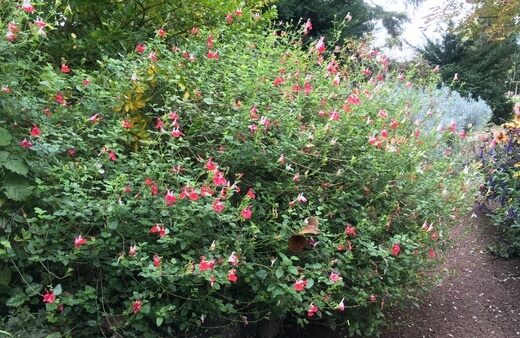
Salvia microphylla is edible, and comes in many forms but my personal favourite has to be the stunningly delicate Salvia ‘Hot Lips’, whose two-tone flowers shine out in the garden with bright red tips on white petals.
Bees adore it, and the leaves have a strong blackcurrant fragrance that tastes somewhere between mint, sage, and summer berries.
- Height & Spread: 1.5mx1.5m
- Edible: Yes
- Annual or Perennial: Perennial
4. Salvia ‘Waverly’ (hybrid)
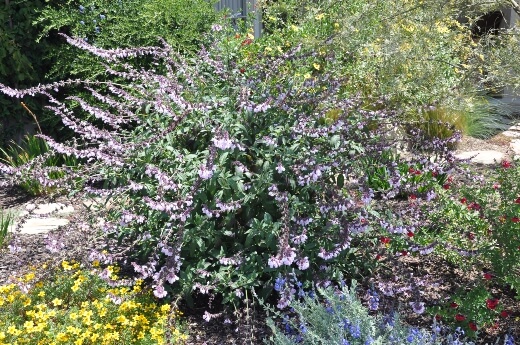
Source: PlantMaster
Salvia ‘Waverly’ is a gorgeous hybrid, but most closely related to Salvia officinalis (the common sage). Its powerfully scented foliage is matched by wonderful peachy pink flowers, and it will readily spread if allowed to do so into swathes of Mediterranean planting that rivals nepeta for its fragrance.


Get Your Free Guide:
Master Growing Australian Natives eBook
A Must Have Complete Guide for Every Australian Garden
Get Your Free Guide:
Master Growing Australian Natives eBook
A Must Have Complete Guide for Every Australian Garden
- Height & Spread: 1mx1.5m
- Edible: No
- Annual or Perennial: Perennial
5. Chia (Salvia hispanica)

Salvia hispanica is better known as chia, producing intensely flavoured seeds that can be ground up and used as a spice, or used to sprinkle over deserts or savoury meals to add a fragrant kick.
The plants themselves are highly ornamental with upright stems and soft fragrant leaves but it needs sowing each year (though in most parts of Australia they will self-seed happily in borders).
- Height & Spread: 1mx50cm
- Edible: Yes
- Annual or Perennial: Annual
6. Salvia coahuilensis ‘Blue Lightning’
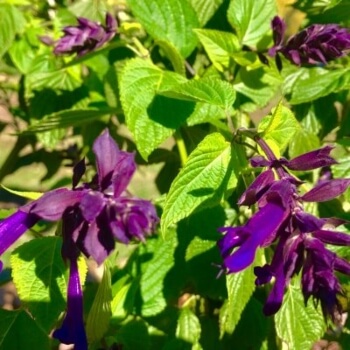
Source: Brenlissa Online Nursery
Blues are really quite hard to find in ornamental plants, so looking at edible species is often a good way to find more vibrant hues. Though Salvia ‘Blue Lighting’ is a sage it isn’t edible, but shares a similar sherbet berry fragrance with its edible cousins.
- Height & Spread: 6cmx1m
- Edible: No
- Annual or Perennial: Perennial
7. Salvia greggii ‘Angel Wings’
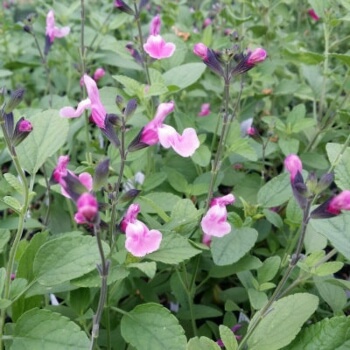
Source: Perennialle Plants Nursery
Salvia greggii are a slightly smaller species in general, and their foliage doesn’t pack the same punch as S. officinalis or S. microphylla. However, their flowers are intensely beautiful, with delicate dark stems bursting into delicate pink buds that open into dusty pink flowers that attract bees with their deep centres (though there is a Salvia microphylla ‘Angel wings’ with less vivid flower tones).
- Height & Spread: 80cmx1m
- Edible: No
- Annual or Perennial: Perennial
8. Salvia gesneriiflora ‘Tequila’
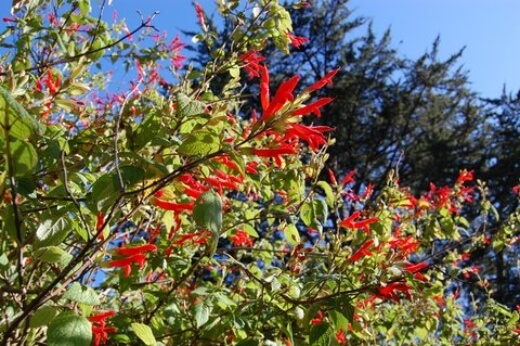
Source: Plant Lust
Salvia ‘Tequila’ is a cultivar from the S. gesneriiflora species, and one of the most vividly crimson perennial salvias you can grow. What sets these stunning perennials off even more is their rich chocolatey stems, which burst into firey red buds in summer.
With regular deadheading, Salvis Tequila provides drama right through summer and into autumn.
- Height & Spread: 60cmx60cm
- Edible: Yes
- Annual or Perennial: Perennial
9. Salvia greggii ‘Pumpkin’

Source: Spring Cottage Plants
Salvia greggii is also known as autumn Sage for its fresh leaves that are available late into the year. Its leaves make a gorgeous zesty addition to salads, and add a fragrance to teas or in baking.
Pumpkin is one of the most divinely coloured salvias, offering rare peaches, which fade out to white as they are pollinated. Regular deadheading will maintain this calming perennial right into autumn.
- Height & Spread: 60cmx60cm
- Edible: Yes
- Annual or Perennial: Perennial
10. Salvia greggii ‘Navajo Pink’

Source: Squak Mt. Greenhouses & Nursery
These Central American natives provide frothy bright green foliage right through spring, summer, and autumn, and can be cut back hard either in early winter or early spring to encourage fresh top growth and retain a neat shape.
The Navajo range of salvias includes reds and whites, but it’s this acid pink that really stands out for me.
- Height & Spread: 55x55cm
- Edible: Yes
- Annual or Perennial: Perennial
11. Salvia greggii ‘Tangerine’
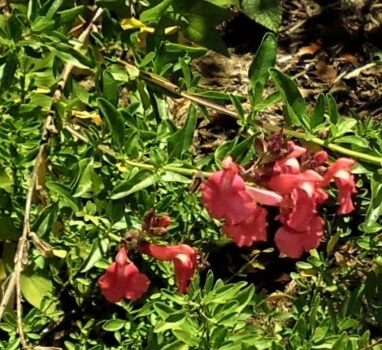
Source: Victorian Salvia Study Group
Tangerine is a bit of a misnomer here as the flowers of this vivid salvia are more like salmon pink. With good care and good drainage, each individual plant can create a mound of at least 1m while in flower.
- Height & Spread: 1mx1m
- Edible: Yes
- Annual or Perennial: Perennial
12. Salvia guaranitica ‘Black and Blue’
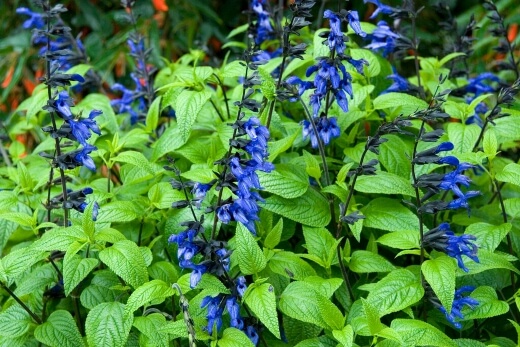
Source: RHS
One of the biggest salvias for your garden is the tall, swaying, Black and Blue. A truly hardy perennial that can be grown in any part of the country and will come back with vigour year after year, providing deep cyan blues for the back of borders.
- Height & Spread: 1.5mx1.5m
- Edible: No
- Annual or Perennial: Perennial
13. Salvia ‘Meigan's Magic’ (hybrid)

Source: Lambley Nursery
Where salvias start to get really exciting is in their sepals, the preliminary petals that cup around the base of each flower. Salvia ‘Meigan's Magic’ is one of the best examples of this, with gorgeous purple sepals, protecting crisp white petals, on highly scented foliage.
- Height & Spread: 1mx80cm
- Edible: No
- Annual or Perennial: Perennial
14. Salvia ‘Black Knight’ (hybrid)
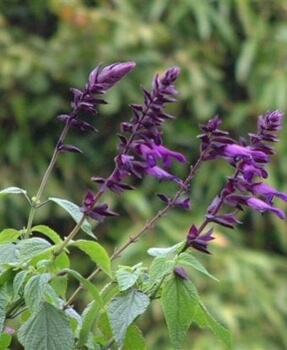
Source: Mudbrick Herb Cottage
This huge purple salvia is unrivalled in its stature, towering over other plants and providing shade in bright gardens. Its black sepals burst into deep purple flowers, ideal for butterflies and long-tongued pollinators.
- Height & Spread: 3mx3m
- Edible: no
- Annual or Perennial: Perennial
15. Salvia involucrata ‘Pink Icicles’

Source: Parkers Place Nursery
Salvia involucrata, also called the Rose Leaf Sage, isn’t edible but fills the air with that iconic sage fragrance while in leaf. Its dramatic bulging pink flowers are unlike any other salvia, and its growth habits can be quite leggy, so it will need staking, and watering regularly on well-drained soil to retain its shape.
- Height & Spread: 1.8mx1.5m
- Edible: No
- Annual or Perennial: Perennial
16. Salvia x jamensis
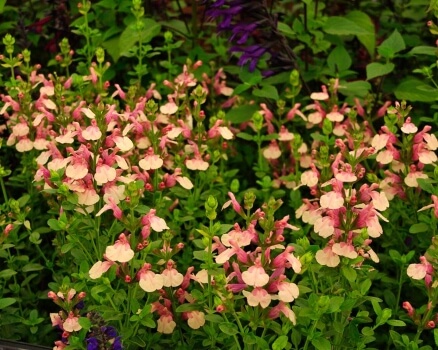
Source: GardensOnline
This attractive range of hybrid salvias boasts a wide range of colours, from pinks to blues and reds, with some peachy white varieties to boot. Its leaves are highly aromatic, and release tons of scent when brushed again, so it makes a great statement plant alongside paths or patios.
- Height & Spread: 1mx1.5m
- Edible: No
- Annual or Perennial: Perennial
17. Salvia leucantha ‘Red Harry’
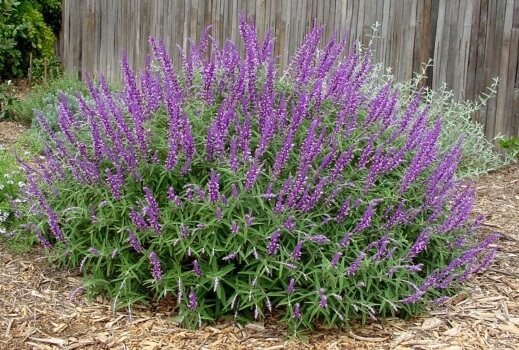
Source: Garden Feast
If you struggle to grow lavender at home, Salvia leucantha ‘Red Harry’ is one of the best alternatives. While we’re all fairly used to using nepeta for that purpose, the fragrance that exudes from S. leucantha will; stop you in your tracks, while its long bracts of flower are an ideal replacement, with longer flowering periods than most alternatives.
- Height & Spread: 50cmx1.5m
- Edible: No
- Annual or Perennial: Perennial
18. Cape Sage (Salvia muirii)
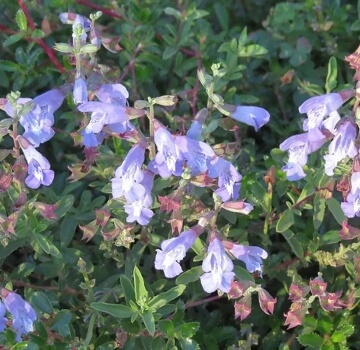
Source: Plant Library
Cape Sage, or wild Sage, is an African species, grown as a relatively low-growing ground cover sage, though its flower spikes can shoot up to about 60cm tall. Its leaves are commonly thought to be edible, but I have to admit I’ve not tried them.
They share a fragrance with common sage, though with a touch of mint.
- Height & Spread: 60cmx60cm
- Edible: Yes
- Annual or Perennial: Perennial
19. Pine Mountain Sage (Salvia semiatrata)
This wiry sage, known as Mountain Sage, or Pine Mountain Sage has dazzling multi-coloured flowers, with deep purple tips, night-sky blue petals and a dusty pink sepal. Its growing form is shrubby, but it will lose all leaves through winter.
For border structure or even dramatic summer pots, Salvia semiatrata is hard to beat.
- Height & Spread: 1.5mx1m
- Edible: No
- Annual or Perennial: Perennial
20. Bog Sage (Salvia uliginosa)
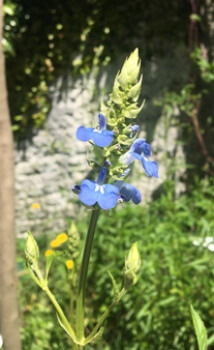
Now, when it comes to the agreed knowledge of how to grow sage, and salvias in general, you will need to throw out the rule book here. Bog sage is a stunning perennial herb, with delicate blue flowers, which can be grown on well-drained soils, but won’t truly thrive until you give it a really, really good drink.
It is one of the few sages that will grow alongside ponds or streams.
- Height & Spread: 1mx60cm
- Edible: Yes
- Annual or Perennial: Perennial
21. Guatemalan Leaf Sage (Salvia cacaliifolia)
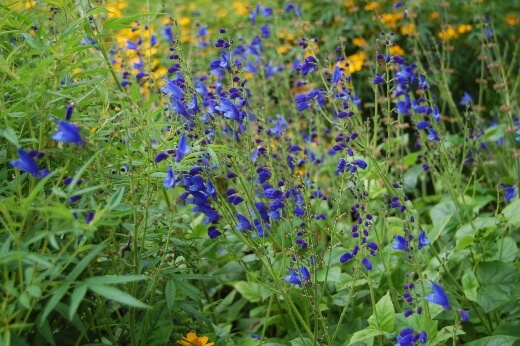
Source: Travaldo's blog
I admit, I’m perhaps being biassed towards the fragrance of salvias, and I understand that there are some gardeners out there who don’t enjoy their pungent fragrance. If that’s you, try growing the Guatemalan leaf Sage, whose soft leaves bear very, very little scent.
- Height & Spread: 90cmx50cm
- Edible: No
- Annual or Perennial: Perennial
22. Chiapas Sage (Salvia chiapensis)
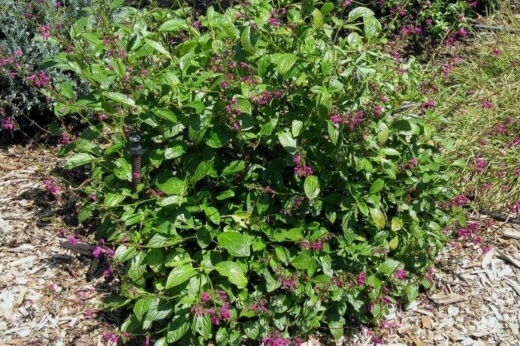
Source: Waterwise Botanicals
With so many cultivated and intentionally bred salvias out there, it can be refreshing to find a pure species Salvia that is still grown and sold for garden use. Salvia chiapensis, with its acid pink flowers and deep brown, dusty stems is a wonderful flowing border plant, which enjoys higher humidity, but does require good drainage too.
- Height & Spread: 1.2mx1.5m
- Edible: No
- Annual or Perennial: Perennial
23. Salvia corrugata
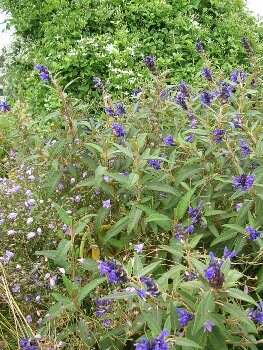
Source: Wikipedia
While they don’t have quite as strong a fragrance as other salvias, the tougher foliage of these blue flowering mountain salvias are great for wet climates, where they enjoy plenty of water in summer, provided they have excellent drainage.
They are ideal for warmer parts of the country, and will need protection from frost in the south.
- Height & Spread: 1.2x1.2m
- Edible: No
- Annual or Perennial: Perennial
Frequently Asked Questions About Sage Plants
Are sage and salvia the same?
While we all use sage to refer to the edible kitchen herb, Salvia officinalis, Sage is the conventional name for salvia, so technically all salvias, whether edible, perennial or annual, are sages, and all sages are salvias.
Do you deadhead salvia?
Salvia will not only respond to deadheading through reflowering, but they double up their efforts in the second flush, so it’s incredibly important to continue deadheading salvia right through the growing season to push their flowers into early winter in some parts of the country.
Should I cut back my salvia before winter?
Salvias should be pruned in spring, and again in late autumn when flowering has completely finished, but before any risk of frost. Nearly all salvias are frost tolerant, but if freshly cut stems are exposed to a cold and wet winter at the same time, they will very often rot, so prune before winter, not during.
What is the best place to plant salvias?
The best place to plant salvias is in a bright, sunny spot, ideally with a gentle breeze to maintain air circulation (which has the added benefit of pushing scent around the garden). Salvias need well-drained soil or compost, and should never be left sitting in water.
Do salvias multiply?
Salvias do not send up volunteers like many shrubs, but they will multiply from layering, either intentionally or by accident if a drooping stem is in contact with the soil in spring and early summer, creating natural new plants.
How many times do salvias bloom?
Perennial salvias will naturally bloom twice in any given year, while annual salvias have a single natural flush of flowers. For both types of salvias, that can be increased by regular deadheading, which will keep them in flower right through summer and autumn.
Are all salvias edible?
Not all salvias are edible, but a surprising amount are. Salvia ‘Hot Lips’, a highly ornamental cultivar, is widely used as an edible plant, with leaves that impart a minty sage flavour to iced drinks, and intensely spiced flowers in summer. Avoid eating annual salvias as they are nearly always non-edible.
Planning to grow your herbs indoors? Check out our compilation of the best indoor herb garden kits and planters in Australia.
Take Your Pick and Start Growing Sage in Your Home
I doubt any plant will ever conjure summer for me like a salvia, and even as they fade into Autumn, their crisping foliage releases a new type of scent that pins itself to your jeans and sticks around like an expensive perfume.
Growing your own salvias at home could not be easier here in Australia, where our climate matches, almost identically, their Mediterranean home.
Published on March 8, 2023 by Maisie Blevins
Last Updated on October 18, 2025

